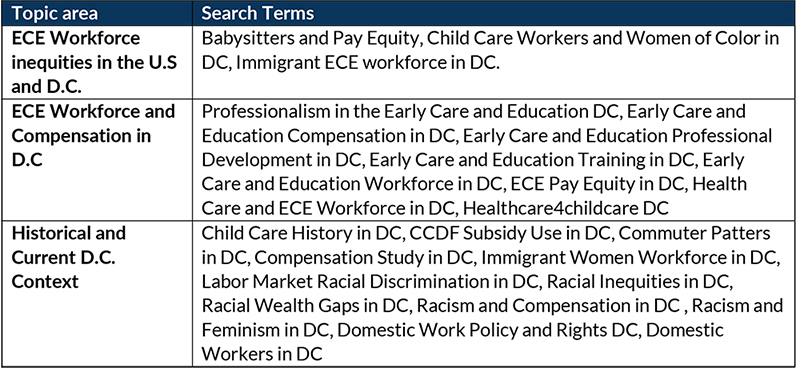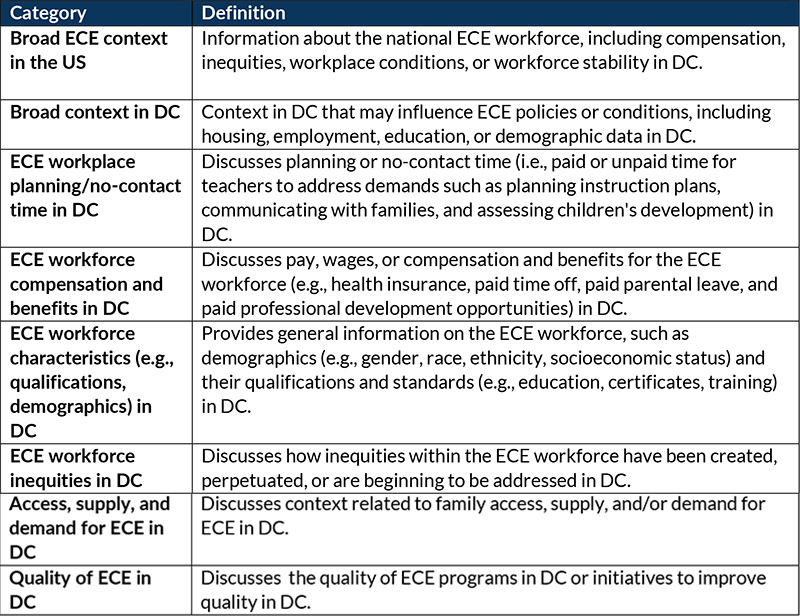
Designing and Implementing the DC Early Childhood Educator Pay Equity Fund | From Vision to Reality - Methods
- Phoebe Harris
- Keiyitho Omonuwa
- Chrishana M. Lloyd
- Julianna Carlson
- Sage Caballero-Acosta
- Michael Martinez
- Dayne Ornelas Gonzalez
- Andrea Vazzano
- Lauren Kissela
The Fund represents the culmination of decades of advocacy and incremental policy reforms. This resource provides an opportunity to learn and share insights about its design and implementation. To capture these lessons, Child Trends conducted an evaluation of the Fund that included an analysis of its historical background as well as research that facilitated a high-level understanding about how the Fund was implemented given its history and immediate impact on educators.
This study sought to explore the following research questions:
-
- What was the catalyst for establishing the Fund? What were the root causes and circumstances surrounding the disparities in compensation within the District’s ECE workforce?
- What groundwork led to the establishment of the Fund in the District?
- How have policy conversations and shifts aligned with the realities faced by ECE educators?
- How do ECE educators perceive and experience the Fund? Do these experiences differ for various groups, such as center-based educators, home-based educators, and educators from specific racial or ethnic groups?
Literature and policy scan
We conducted a literature and policy scan to explore both the local and national context surrounding ECE compensation. We reviewed peer-reviewed academic literature, data points, legislative reports and policy, and gray literature, including book chapters, policy briefs, and reports. Literature was identified through Google, Google Scholar, ERIC, Research Connections, JSTOR, and ProQuest. Additionally, we included literature as recommended by interview participants and completed backwards citations searches of identified literature.
Literature was included in the final analysis if it addressed ECE compensation or the ECE workforce in the District and/or in the United States or provided historical and current context of ECE workforce inequities in the District. We established these criteria so that we could examine the root causes and current circumstances regarding the development, design and implementation of the Fund in the District while also considering national ECE context.
The search terms used in this landscape analysis were informed by those used in other foundational reports exploring the historical basis for workforce inequities and compensation (see Lloyd, et al., 2021). Table B1 outlines the topic areas and search terms used for the scan.
Table B1. Topic areas and search terms

Note: each search term had a series of variations that were included in the search. For example, babysitters may have been searched using “babysitter” or “nanny.”
Once literature was identified it was logged in an Excel spreadsheet for analysis. Key information from each resource was documented, including year published, first author, type of resource, ECE setting discussed, and years/time period reviewed in the article. Literature was then assigned to one of the categories outlined in Table B2.
Table B2. Analysis categories and definitions
We conducted similar searches within local news reporting agency websites to identify major events and/or changes occurring within the District’s ECE landscape. Reviewing news articles helped to identify significant ECE policies that were proposed or passed and in-the-moment reactions from the public. Our goal was to identify these major events and understand various perspectives on the issue.
Primary data collection
Key informant interviews
We conducted exploratory interviews between June and September of 2023 with 14 individuals who played major roles in advocating for, designing, or implementing the Fund.
The interview guide was designed to address the project’s research questions, with an emphasis on uncovering more in-depth historical information. The interview guide was tailored to each participant’s background and involvement in the Fund, covering the following topics:
- Interviewee’s background and connection to the Fund
- Historical background related to the Fund and ECE in the District
- The process of advocating for and designing the Fund
- The implementation of the Fund
- The anticipated or experienced impact and effects of the Fund
- Recommendations
We invited interviewees according to their connection to the Fund to ensure a wide breadth of perspectives and roles were included. Each interview took place over Microsoft Teams and was recorded, with permission from each interviewee. We used snowball sampling to identify interviewees, asking each participant to identify other relevant individuals for our team to interview who had insights about the genesis and implementation of the Fund. We offered interviewees a $100 gift card after completing the interview. Interviews continued until the team reached a saturation of recurring themes regarding each topic area.
Interviews were analyzed using Dedoose, a qualitative analysis software. One team member developed a draft codebook to summarize recurring themes and ideas presented in the interviews. Other members of the study team reviewed the codebook to ensure it mirrored the protocol and topics that emerged from the interviews. Each interview transcript was double coded and reviewed by both coders until consensus was reached.
Focus groups
In early 2024, we conducted focus groups with ECE educators and directors/administrators. A team of researchers knowledgeable about the District’s context and the Fund developed and reviewed the focus group protocol. The team designed the focus group questions based on the projects’ guiding research questions, with an emphasis on understanding the group’s unique impressions of the Fund, experiences learning about or accessing the Fund, and any impressions or ideas they may have about the Fund moving forward.
Our goal was to conduct focus groups with English and Spanish-speaking educators and directors/administrators. We formed these groups to gain insight from diverse educators based on role (educator vs administrator/director) and preferred language (English vs Spanish). Providers were recruited through ECE stakeholder groups in the District, who contacted their networks of providers about the opportunity. At the point of recruitment, we gathered basic demographic data to be able to summarize the characteristics of the sample. All participants were age 18 years and above, per our selection criteria.
Overall, we conducted 5 focus groups with 20 educators (9 Spanish-speaking; 11 English-speaking) and eight center directors/administrators (all English-speaking). Although we conducted extensive outreach to home-based educators, there was not enough interest to hold a focus group. The focus groups were held virtually via Microsoft Teams and were offered in both English and Spanish. Each session lasted 60 to 90 minutes. Participants received $60 after participating to thank them for their time.
Because different groups (e.g., educators vs directors) experience the Fund in different ways, the focus group guide was tailored to each group’s background and probable knowledge of the Fund. The focus group guide covered the following topics:
- Participants’ overall experiences with the Fund and HealthCare4ChildCare
- Successes and challenges with the Fund and HealthCare4ChildCare
- Payment schedule preferences
- Impact of payments and insurance on participants’ lives
- Participants’ knowledge of HealthCare4ChildCare
- If they are using insurance benefit, and if not, why?
- How administrators support educators in receiving benefits of the Fund
- What could be improved about the Fund, including insurance
- The Fund’s impact on hiring processes, recruitment, retention
Focus group facilitators and notetakers debriefed after each focus group to highlight key takeaways which contributed to the creation of the codebook. Other members of the study team reviewed the codebook to ensure it mirrored the protocol and topics that emerged from the focus groups. After the completion of all focus groups, the analysts then systematically coded the focus group transcripts using Dedoose and remained in communication throughout to maintain inter-rater reliability.
Photovoice
In the Spring of 2024, 25 educators engaged in a photovoice activity to share their experiences with the Fund. Photovoice is a community-based participatory research method that actively engages community members as partners throughout the research process. In a Photovoice project, participants take photos in response to questions of interest, craft short narratives describing what their photos represent, and then meet in groups to share and discuss their work.
Educators were recruited for the Photovoice activity through the focus groups and community organizations sharing the opportunity with their networks (e.g., Multicultural Spanish Speaking Providers Association [MSSPA], Under3DC). Eligibility criteria included being 18 years or older, being eligible to have received benefits from the Fund and being willing to participate in Photovoice meetings in either English or Spanish. Ultimately, we enrolled 25 educators, who were organized into four groups based on educator language preference and availability for meetings. Child Trends facilitators led Photovoice sessions with two groups in English and with the remaining two groups in Spanish. Each photovoice group met with Child Trends facilitators a total of three times, with meetings held approximately two weeks apart. Photovoice participants received a total of $500 ($150 for the first two meetings and $200 for the third) to offset time and travel costs.
The first session was conducted in-person at space donated by the MSSPA. This meeting introduced educators to the project and Photovoice methods, including instructions on how to take photos for the purposes of this project (e.g., how a photo can communicate a feeling or an idea). At the end of the session, educators were asked to complete a photo assignment. Specifically, educators were asked to take photos that answered specific questions, write a caption for their photos, and upload them to an online system. The questions of interest were:
- How has your life changed (or not) because of the supports from the Fund?
- What challenges do you face as an ECE educator that you want others to know about?
- What do you hope for the future for ECE educators in the District?
The second session was also held in-person at MSSPA. At this session, educators were again convened in-person. Facilitators prepared a presentation with all educators’ photos and captions, and educators took turns presenting and discussing their photos and captions. At the end of the discussion, facilitators led an exercise to identify and come to a consensus on key themes that came up in the photos and discussion. Educators were given the option to take additional photos in preparation for the final session.
The final session was held virtually via Microsoft Teams. Facilitators again prepared a presentation with any additional photos and captions, and educators took turns presenting and discussing these. Facilitators then presented a summary of the key themes identified from the previous session, along with themes identified by other groups. Educators were then given the chance to validate and refine this summary, which appears in the online photo exhibition.
Suggested Citation
Harris, P., Omonuwa, K., Lloyd, C., Carlson, J., Caballero, S., Martinez, M., Ornelas Gonzalez, D., Vazzano, A., & Kissela, L. (2025). Designing and implementing the DC Early Childhood Educator Pay Equity Fund | From Vision to Reality. Child Trends. DOI: 10.56417/3742h5747n
© Copyright 2025 ChildTrendsPrivacy Statement
Newsletter SignupLinkedInYouTubeBlueskyInstagram